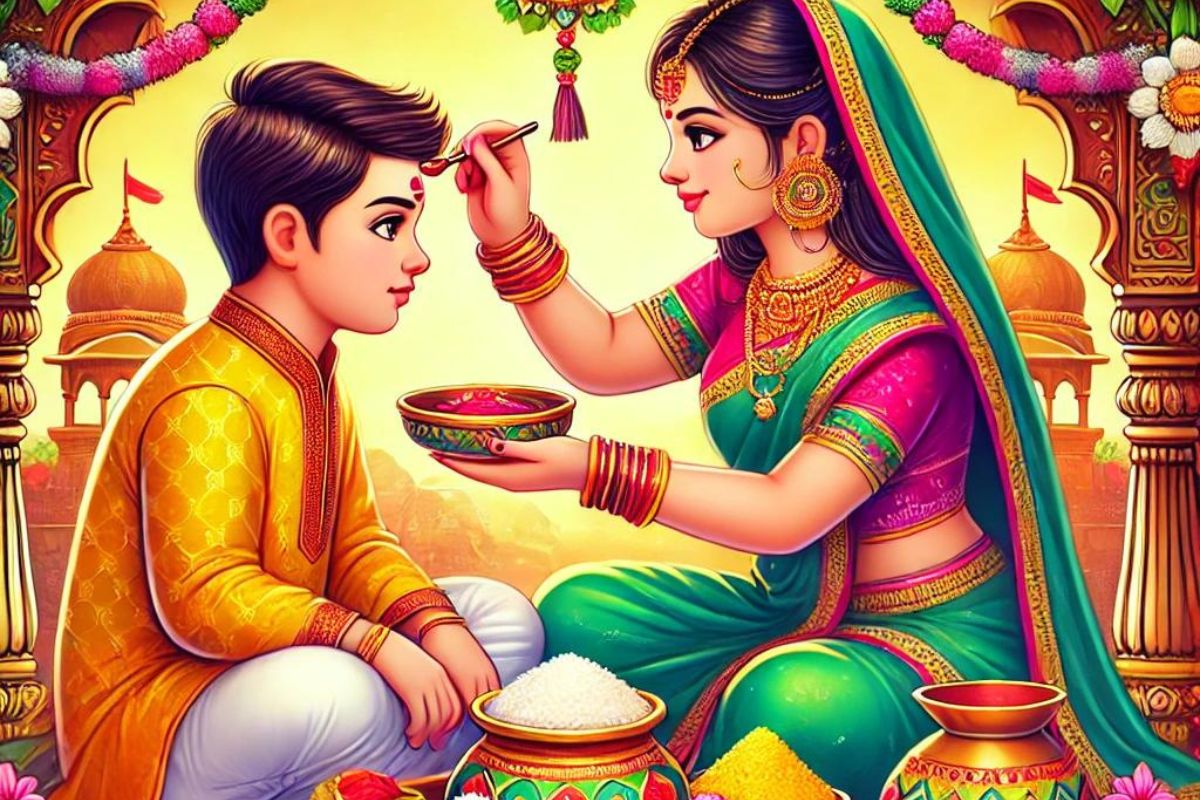Bhai Dooj, also known as Bhaiya Dooj, is a cherished Hindu festival that honors the unique bond between brothers and sisters. Falling on the second day after the new moon in the month of Kartik, it marks the conclusion of the Diwali festivities. In 2024, Bhai Dooj will be celebrated on Sunday, November 3rd. Let’s delve deeper into the auspicious timings, rituals, and significance of this special day.
Auspicious Timings (Shubh Mahurat)
For Bhai Dooj in 2024, the most auspicious time to perform the tilak ceremony is from 1:30 PM to 3:47 PM. This 2-hour and 17-minute period is considered highly favorable for the rituals. The Dwitiya Tithi, which is crucial for the celebration, begins at 8:20 PM on November 2nd and concludes at 10:07 PM on November 3rd , 2024.
The Deep Significance of Bhai Dooj
Bhai Dooj is more than just a festival; it is a heartfelt celebration of the lifelong bond between siblings. The term “Bhai” means brother, and “Dooj” refers to the second day after the new moon, which is when this festival is observed. On this day, sisters pray for their brothers’ long life and prosperity by performing the tilak ceremony, which involves applying a sacred mark on the brother’s forehead. In return, brothers present gifts to their sisters as a token of their love and appreciation .
Rituals of Bhai Dooj
The rituals of Bhai Dooj are rich in tradition and vary across different regions of India. Here is a detailed guide to performing the Bhai Dooj Puja:
- Preparation:
- Both siblings wake up early, take a bath, and wear fresh or new traditional clothes.
- The sister prepares a puja thali (a plate for rituals) containing roli (vermilion), rice, sweets, a diya (oil lamp), flowers, and a coconut.
- Tilak Ceremony:
- The sister applies a tilak on her brother’s forehead, symbolizing her prayers for his well-being and prosperity. This tilak is usually made from a mixture of roli and rice. In some regions, additional elements like kajal (kohl) and sandalwood paste are used.
- The sister performs an aarti for her brother, moving the puja thali in a circular motion in front of him. This ritual invokes blessings for the brother.
- She then offers sweets and other homemade delicacies. Special dishes like basundi puri in Maharashtra and khaja in Bengal are prepared for the occasion.
- Exchange of Gifts:
- After the tilak and puja, the brother presents a gift to his sister. This exchange of gifts strengthens their bond and brings joy to both.
- Blessings and Feasting:
- The brother touches his sister’s feet as a mark of respect and seeks her blessings. The celebration concludes with a family feast, where everyone enjoys the specially prepared meals.
Regional Variations
Bhai Dooj is celebrated with various names and customs across India. In West Bengal, it is known as Bhai Phonta, where sisters fast before performing the tilak ceremony. In Maharashtra and Goa, it is called Bhao Beej, and the rituals are typically performed in the evening. In Uttar Pradesh, sisters give dried coconuts to their brothers as part of the ceremony.
Mythological Stories Behind Bhai Dooj
Several mythological tales are associated with Bhai Dooj, adding to its cultural richness:
- Lord Krishna and Subhadra:After defeating the demon Narakasura, Lord Krishna visited his sister Subhadra, who welcomed him with a tilak and offered him sweets and flowers. This warm reception is commemorated as Bhai Dooj .
- Yamuna and Yama:The God of Death, Yama, visited his sister Yamuna on Bhai Dooj. She welcomed him with a tilak and a feast, and he granted her a boon that brothers who receive tilak from their sisters on this day will live long and prosperous lives. Hence, Bhai Dooj is also known as Yama Dwitiya in some regions .
How to Celebrate Bhai Dooj
Celebrating Bhai Dooj involves several steps, each filled with symbolic meaning:

- Early Morning Preparations:
- Siblings dress in their best traditional attire and gather all the necessary items for the puja.
- Setting Up the Puja Area:
- A clean and decorated space is set up with idols of deities, flowers, and a diya.
- Performing the Tilak Ceremony:
- The sister applies the tilak on her brother’s forehead, prays for his well-being, and performs an aarti.
- Sharing Sweets and Gifts:
- The sister offers sweets, and the brother presents a gift to his sister. This mutual exchange symbolizes love and respect.
- Family Feast:
- The day concludes with a festive meal shared among family members, making the celebration even more special and memorable.
Conclusion
Bhai Dooj is a beautiful celebration of the bond between siblings. It reinforces familial ties, spreads joy, and ensures blessings for both brothers and sisters. By understanding and participating in these rituals, we honor the traditions passed down through generations, bringing warmth and love into our homes.
For more detailed information and guidance on performing the rituals, consider referring to trusted sources and guides available online.
Also Read | Raksha Bandhan 2024: Unbreakable Bonds and Heartfelt Celebrations


